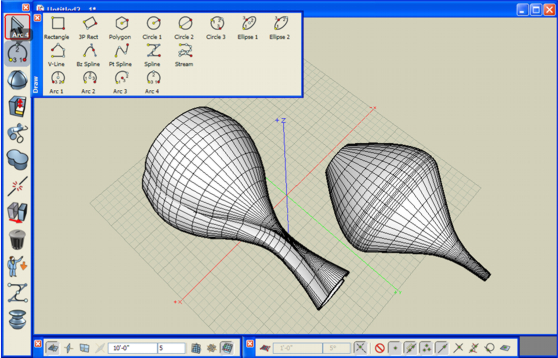May 8, 2009
Last August, SIGGRAPH attendees got a glimpse of bonzai3d, a new 3D modeler from AutoDesSys. The new product was touted as a lighter, smaller version of formZ, a well-known NURBS modeler* from the same company. In the announcement, AutoDesSys described bonzai3d as “an offspring of formZ” and a “3D modeler developed to fill in the demand for a quick, easy, simple but, most importantly, geometrically robust approach to 3D.”
This May, at AIA Convention (Moscone Center, San Francisco, California), AutoDesSys’ founder and CEO Chris Yessios began handing out DVDs containing the beta release of bonzai3d. So I picked up one. It was literally a very small program. Without the materials and content library, the program folder was a mere 150 MB.

Nevertheless, the software works like a robust 3D package, with ample NURBS editing tools to produce complex geometric shapes and surfaces. It comes with a menu specific to architecture (walls, windows, and staircases that you can drag, drop, and resize, for example), but because of its ability to produce sweeping profiles, it could easily be deployed for conceptualizing consumer goods.
The interface is quite intuitive. Without watching the tutorial videos, I was able to start using it by experimentation. It offers a good collection of export options, including DWG, DXF, KMZ, 3D Studio, LightWave, and OBJ. The software had a few hiccups when I attempted to apply the Round or Taper command on some surfaces with odd profiles, but I expect these issues to go away when the code matures. You can try it out for yourself by downloading it from www.bonzai3d.com.
[Note: According to AutoDesSys, form.Z and bonzai3d are NURBS modelers, but can also do much more. Alexandra Yessios, the company’s VP of marketing, said, “They have multiple personalities, including NURBS ... While we do as much as Rhino does with NURBS, we do more types of modeling: facetted, smooth, subdivisions, metaballs, coons patches, etc. (the latter three in form.Z only).”]
For more, watch the video clip below.
Subscribe to our FREE magazine, FREE email newsletters or both!
About the Author
Kenneth Wong is Digital Engineering’s resident blogger and senior editor. Email him at [email protected] or share your thoughts on this article at digitaleng.news/facebook.
Follow DE





